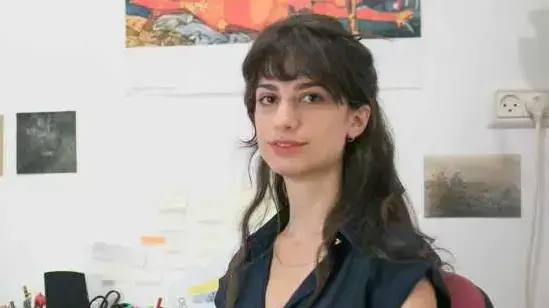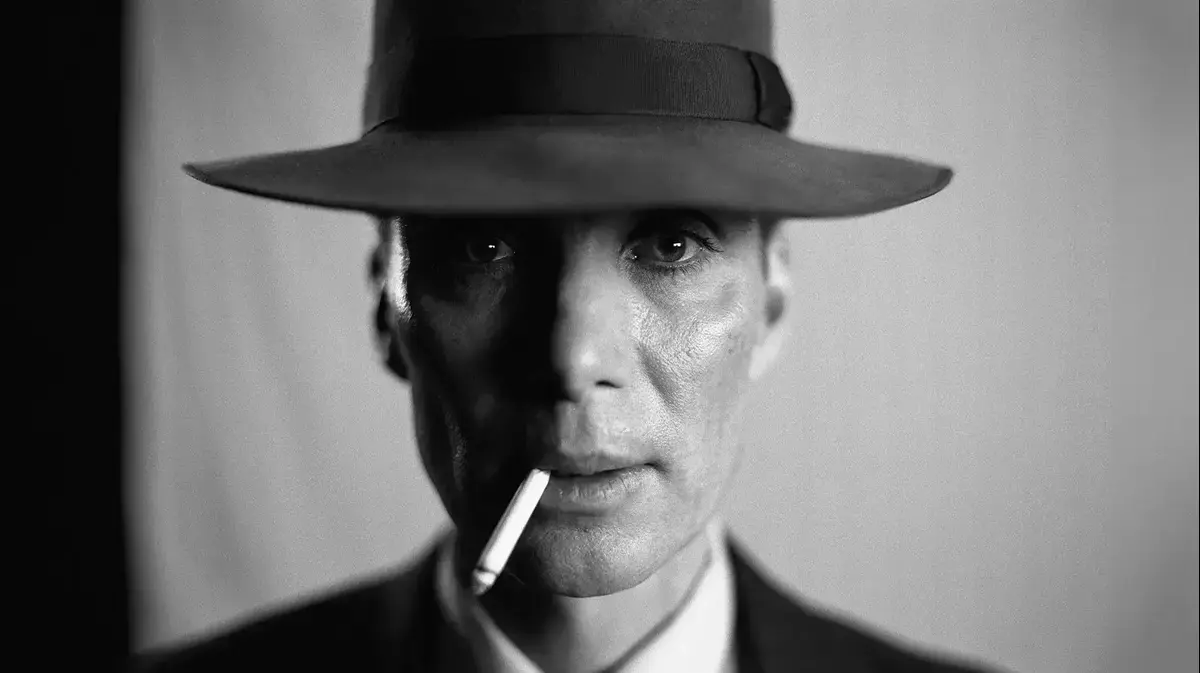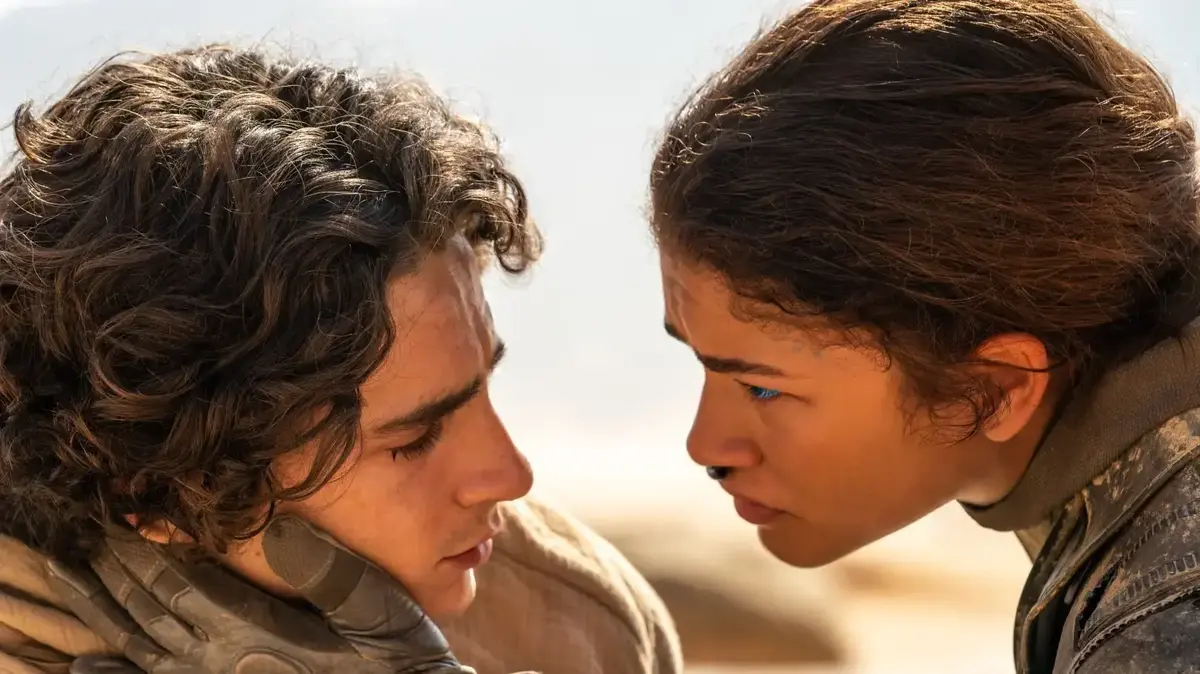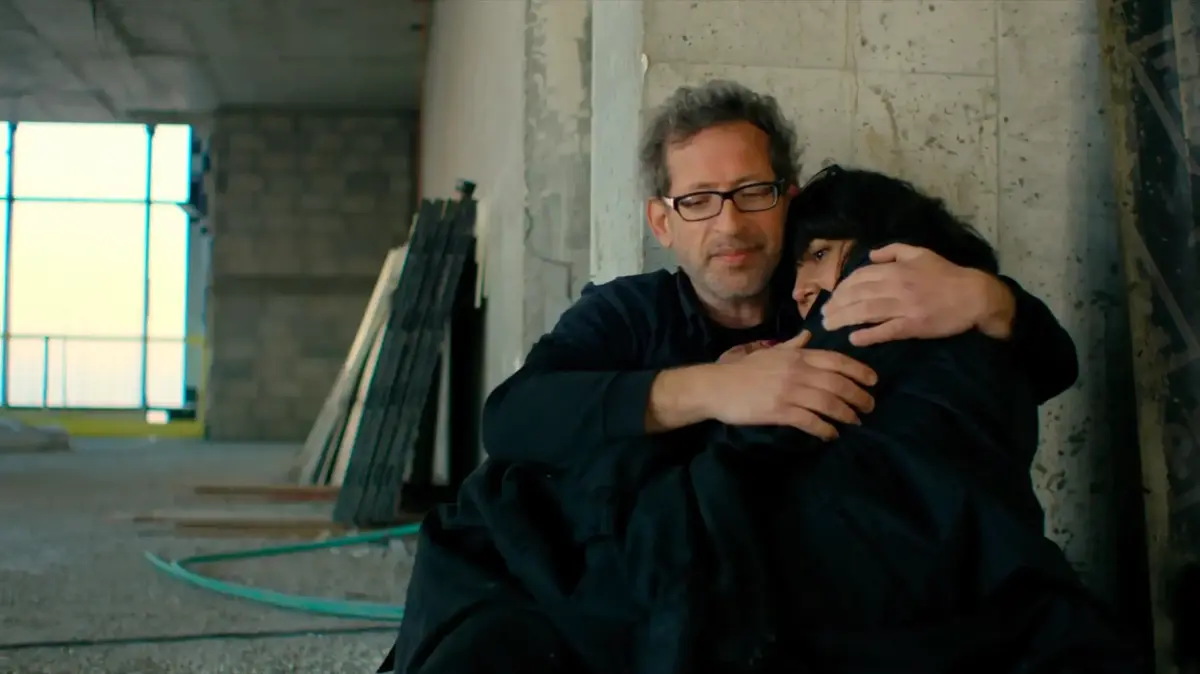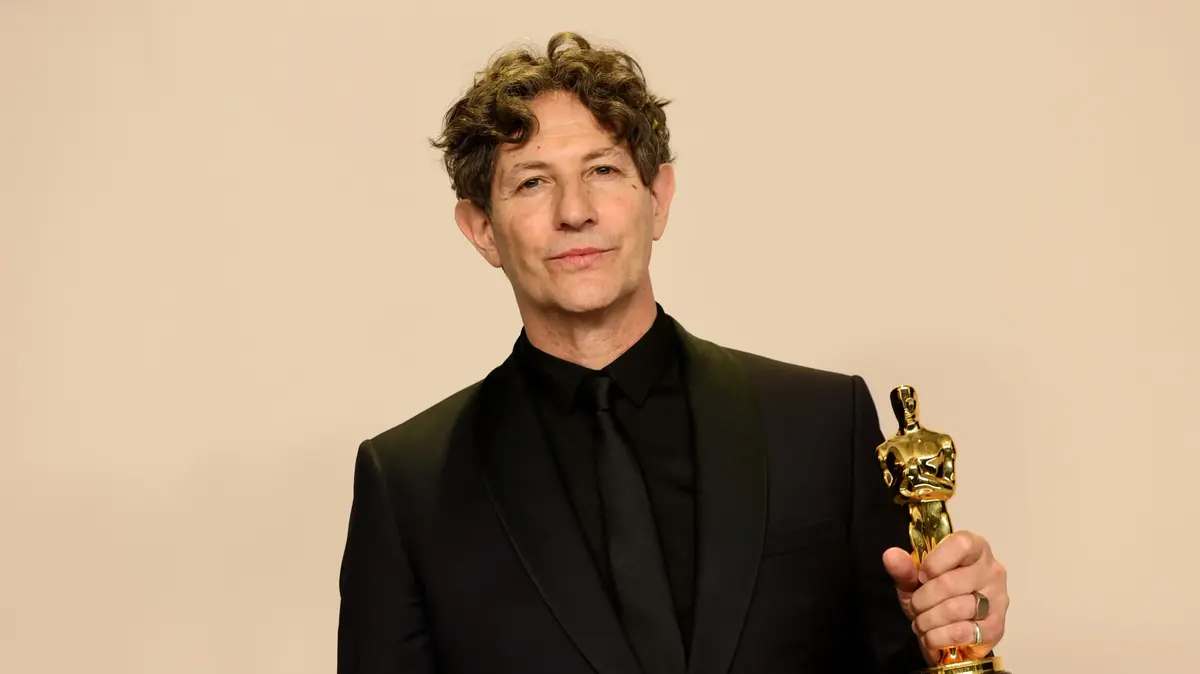She dreamed of a pig saving a Jew in the Holocaust.
It became a masterpiece and an award-winning film
Based on a childhood memory, Tal Cantor created "Letter to a Pig", a short, award-winning animated film about a girl who hears from a Holocaust survivor about the pig that saved him from the Nazis.
In an interview, she tells how she learned that pigs are not what she thought
Avner Shavit
09/08/2022
Tuesday, 09 August 2022, 00:01
Share on Facebook
Share on WhatsApp
Share on Twitter
Share by email
Share in general
Comments
Comments
Trailer for the movie "Letter to a Pig" (The Hive Studio, Miyu Productions)
Since she was in high school, director Tal Kantor has been haunted by a childhood memory: her class met a Holocaust survivor, who told them that a pig saved his life.
Although the animal is considered impure in Judaism, in his case it turned out to be a guardian angel, and its body separated him from the Nazis who were looking for him.
The Jewish survivor of course did not forget the pig, and years later wrote him a letter of thanks.
This unique story intervened in Kantor's dream, and these memories left a strong impression on her.
He did not let go of her even in her adulthood, until a few years ago she decided to turn them into a cinematic piece that would deal with the meeting of the Holocaust survivor with the pig, and the meeting of the schoolgirl with both.
The result is a 15-minute animated film called "Letter to Pig", which became one of the most talked about short Israeli films of the year.
It had its world premiere about two months ago at the Anancy Festival, the flagship event of the world of animation, and its Israeli premiere at the Jerusalem Festival about two weeks ago, from which it came away with the award for the best animated short film.
Tomorrow (Wednesday) the list of candidates for the Ophir Award will be published, and he is expected to be among the five candidates in the short film category.
The general public will be able to enjoy it next week as part of the Animax festival, which will be held at the Tel Aviv Cinematheque and in various complexes around the city and will present a variety of long and short animated films.
The success of "Letter to Pig" strengthens Cantor's position, in her early thirties, as one of the most prominent animation producers in Israel.
She broke through a few years ago with "In other words", a six-minute long film that was screened at more than a hundred festivals around the world, and since then she has also worked in other people's films - for example, she directed the animated segments in the controversial docu "Leah Tzamel, Lawyer".
Ari Pullman, who directed "Waltz with Bashir" and can be seen as the father of the contemporary animation industry in Israel, recently defined Kantor in an interview with "Cultural Agent" in Khan 11 as "an amazing, brilliant and original creator in an unusual way."
He described "Letter to a Pig" as a "tremendous film, which will go very far".
After such praise, such a producer, every word is unnecessary, and yet we allow ourselves to add a few words.
"Letter to a Pig" is a masterpiece film, which manages to deal with the memory of the Holocaust in a mesmerizing way, and from a new angle.
"This movie will go far."
From "A Letter to a Pig" (Photo: The Hive Studio, Miyu Productions)
Like Pullman, Cantor is also the granddaughter of Holocaust survivors - her grandfather, Israel Cantor, is a Holocaust survivor whose family perished in Poland, and in the Yad Vashem collection there is a series of paintings he painted called "Maydank".
The heroine of the film is a high school student similar to her character, but in the film version she does not necessarily have any family connection to the horrors of the war.
"This is part of the idea of the film - even though the student is not directly related to the Holocaust survivor or what he tells, she nevertheless takes his stories deep into her heart," says the director in an interview with Walla!
culture.
"Although she is neither second nor third generation, these stories become part of her collective memory and perception of identity."
At the beginning of the film, a Holocaust survivor tells the students that they cannot understand what he went through and experienced.
After working on the film, do you feel you understand?
Do you understand a little more?
Don't understand at all?
"That's exactly what the film deals with. I don't think it's possible to really understand something so huge and unimaginable as the horrors and extremes that human nature can reach. There is no simple way to 'crack' it. There will always be a complex perception gap between the generations. There is something I do understand More following the film - the fact that these atrocities can have a profound effect even on the generation that did not experience them, and unconsciously. There are all kinds of approaches to dealing with trauma and post-trauma even when it is collective."
The Holocaust survivor also adds "and it's a good thing you can't understand."
That is, that it is better to stay away from what he understood.
You actually got closer, you dived into the horrors of the Holocaust.
why did you do this?
It's already complicated to make an animated film, so why on such a subject?
"Wow, throughout the work on the film I asked myself this question quite a few times. Animation is a Sisyphean creative process anyway, so using it to deal with such a heavy and charged subject affected my mood and mind during the development and production. There must have been something big burning there I want to tell and get it out. The more I delved into the film, the more I discovered how important and relevant it is to me to get it out into the world now, despite the difficulty involved."
More in Walla!
The ballad about Ari and Anna
To the full article
"Amazing, brilliant and original in an unusual way".
Tal Kantor (Photo: Noam Moskovitz, Avner)
These memories accompany you since your youth, why did you decide to turn them into a film only at this stage of your life?
"Apparently I needed maturity, professional experience and perspective to approach such a complex subject and story. Apparently this is one subjective story, but there is also something bigger here than my personal memory and the personal story of that Holocaust survivor. The Holocaust in the Israeli collective memory is an opportunity for me to examine bigger questions - For example, the inheritance of trauma, the way historical narratives are passed from generation to generation, and the question of what emotional, social and political consequences this has for the younger generation. What do we do with all this heavy baggage? How does it affect our perception of identity and our social and moral perspective? "
The film is called "Letter to a pig" and of course "pig" is a word with many charges in Hebrew, and a taboo.
Did you have any hesitation before choosing this name?
What does it mean to you?
"The last time I worked on a film, its name changed several times until it settled on 'In other words.' 'Pig' emerges as an intriguing, tense and even confusing contrast, which embodies many of the questions and layers found in the film itself. And, the charge surrounding this particular animal is part of that."
How I stopped being afraid and learned to love pigs.
Tal Cantor in the filming of "A Letter to a Pig" (Photo: Matthias Carre)
For the purpose of designing the character of the pig in the animation, Cantor visited the freedom farm and met real pigs there.
"The pig has negative connotations, and this animal is used to describe ugly features of people, and I admit that I was also put off by it at first because of these prejudices," says the director.
"While working on the film, I discovered how full of character, sociable and communicative pigs are. They bond just like dogs. I was surprised to discover how many similarities there are between a pig and a human - the eyes, skin, intelligence and sensitivity. Did you know that an adult pig has the cognitive capacity of a four-year-old child ? In short, by the end of the film I really fell in love with this animal. What's more, it's not that easy to work with them. They have a slow and clumsy image, but they're really fast and it's almost impossible to catch them on camera, especially when they're young. The team and I wallowed in the mud quite a bit with them." .
"A Letter to a Pig" uses a unique technique in which actors (or pigs) are first photographed in the flesh, and then an animation is created based on their real movements.
The character of the Holocaust survivor is "played" by Alex Peleg, who died after filming, and this is one of his last roles.
"When we met for the first time, in a cafe below his apartment, he read the script out loud, slowly and with emotion. There was something powerful about his presence," Kantor recalls.
"He was already in the last stages of his life, and basically avoided acting work, but when he read the letter that the survivor wrote to the pig, as improvised as he was in a cafe, I felt such a tremor in my body and I knew it had to be him. After a campaign of persuasion by Amit Gitzlater, the dear producer of The film, Alex relented. He did such a great job that quite a few viewers thought it was a doco, and asked me if I filmed the Holocaust survivor. When the bitter news of Alex's death came, I was heartbroken. I was sorry he didn't get to see the finished film.
The schoolgirl is "played" by Moriah Meyerson.
"She is not yet a well-known actress, but this is a great talent," says Alia Kantor.
"Her character doesn't have a single line of dialogue, but she manages to express many shades of emotion with a look and subtle gestures. We did rehearsals and a lot of guided imagination games and simulations, because much of the film was created afterwards in animation, when she is not actually standing in front of a Holocaust survivor or a giant pig. Moriah She agreed to devote herself to the process and allow me to get close to her most precious and sensitive places, and this allowed me to convey the entire range of emotions that pass through her throughout the film."
Unique and mesmerizing.
From "A Letter to a Pig" (Photo: The Hive Studio, Miyu Productions)
You said that it was important for you to convey an emotion in the film.
For you, what emotion is this?
excitement?
fear?
completion?
Brotherhood?
"The film is an emotional journey into the space of the subconscious, which is an inner and more abstract place in our subconscious, where there is no longer a clear narrative and there are mainly raw feelings - where we meet our ugly and scary demons. After going through all this charged range, it was important to me that at the end of Something will also be an emotion of compassion - a softer and brighter look towards the future, which also has qualities of hope and healing."
A rather stupid question: I couldn't help but notice that during the description of the meeting in class, you focus on the daughter who survived the Holocaust, and the biscuit he dips in it.
It's not obvious and doesn't advance the plot, so I wondered why?
"It's based on a moment from my childhood. In the twilight of his life, my grandfather could no longer see well or hear well. He dipped a cookie in his tea while talking about his memories, and he spoke so fluently that he forgot the cookie in his face for a long time. I couldn't concentrate on what he was saying because I ate a cookie, which was left hanging there and slowly dissolved. This memory suited me as a metaphor for the tension created in the classroom between the Holocaust survivor and the students."
The film was screened in France and also in Israel.
How were the reactions here and there?
How are the reactions in the world different compared to the reactions in Israel?
"The viewers are not always sure that they fully understood the film, but when I ask what they understood, we find that they actually understood a lot. Both here and there, the reactions are moving. Even viewers who did not grow up here, connect to the film personally because of its dealing with intergenerational trauma, which is a universal theme Several people have already told me that this film is important beyond the Israeli narrative of Holocaust remembrance, because it deals with the global question of how we perceive those who are different from us, and how we treat or not treat trauma. There are elements in the film that are easier for the Israeli audience to understand - for example the siren And the white shirts on Memorial Day, or even the chargers that come with the pig, but I'm happy to discover that none of this prevents viewers abroad from understanding the essence of the film and being moved by it."
One of Alex Peleg's last roles.
From "A Letter to a Pig" (Photo: The Hive Studio, Miyu Productions)
Ari Pullman is one of the biggest fans of the movie.
Do you remember the first time you saw his "Waltz with Bashir"?
"I will never forget my first viewing of it. The film shook me so much that I did not relax for several days. I did not believe that a film could revive and transmit with such power an emotional experience of remembering an event that I had never been to. The film taught me that animation has a unique ability to connect the viewer For a subjective and fluid experience like a memory. Every time I traveled the world with my previous film, there was no place where they didn't talk to me about 'Waltz' as soon as they realized I was from Israel. Ari changed the face of global creativity with this film, and opened a door for the connection between docu and animation. In recent years, you can see More and more hybrid works that combine the two worlds, which is very gratifying."
Even now do you dream at night about pigs and the holocaust?
"The truth is not. And let's just say that even if it is, I'm repressed"
except for the promotion of "Letter to a pig",
"I'm helping a couple of creators from Belgium who are developing a virtual reality project, and it's also related to the experience of dementia and memory loss - it's interesting that the theme of memory continues with me in other people's projects as well. In the meantime, I'm also developing some personal projects of my own, but maybe they won't deal with memory anymore. We'll see It's time for me to live a little in the present."
The film will be screened at the Tel Aviv Cinematheque as part of the Animax festival on Wednesday 10.8 at 18:00, Friday 12.8 at 14:30 and Saturday 13.8 at 17:30.
After the screening on Saturday, there will also be a meeting with Cantor.
To purchase tickets see the official website
Five more films to watch out for at the festival
"Little Nicola - happy to the roof" - the big winner of the Anancy festival two months ago.
A beautiful and clever animated film about the writing process of "Little Nicolas", the popular children's books in the history of France
"The Iron Giant" and "The Emperor has fallen on his head" - a special screening of two Hollywood animated films that were not a great success when they were released, but became a cult over time
"Dogs, dogs and more dogs" - a collection of animated films from all time dealing with man's (and the animator's) best friend
"Inu-ho" - a local and almost world premiere screening of a new musical anime film, which will be shown in Israel at the same time as its release in Japan.
For screening dates and purchasing tickets see the official website
culture
Theater
Cinema news
Tags
Tal Cantor
Ari Pullman
holocaust
pig

